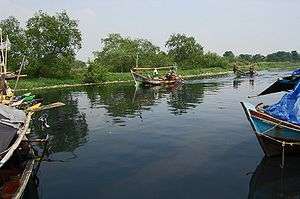Muara Angke Wildlife Reserve
Muara Angke mangrove forest and wildlife sanctuary is a protected nature conservation area at Kapuk Muara, Penjaringan along the north coast of Jakarta, Indonesia. Muara Angke Wildlife Sanctuary is located at the end of Muara Karang Raya street, near Mediterranean Gallery shopping complex.

History
Muara Angke Wildlife Sanctuary was protected since the colonial rule of the Dutch Indies on June 17, 1939, covering an area of 15.04 ha. During the 1960s, the conservation area was expanded to 1,344.62 hactares. Later, because of human pressure and environmental destruction within and around the national park, some of the mangrove forest area were destroyed.
On February 28, 1988, the area was declared a Nature Reserve (25.4 ha).[1] In November 1998, the status of this area changed to Wildlife Sanctuary or Suaka Margasatwa (25.02 ha).[2] Muara Angke Wildlife Sanctuary is listed as one of the important bird sanctuary in Java, protecting bird species such as milky stork and the endemic Sunda coucal.[3] Muara Angke Wildlife Sanctuary is currently facing issues such as mangrove cutting, water pollution (especially in Angke River), and settlements development at the edge of the area.[4]
Vegetation
Recorded about 30 species of plants and 11 of them are tree species in the mangrove forest. The mangrove trees include the mangroves ( Rhizophora mucronata , R. apiculata ), fires ( Avicennia spp.), Pidada ( Sonneratia caseolaris ), and the blind wood ( Excoecaria agallocha ). Several types of mangrove plant associations can also be found in this area such as ketapan ( Terminalia catappa ) and nipah ( Nypa fruticans ). In addition to the above types, there are also several types of trees planted for reforestation. For example Javanese acid ( Tamarindus indica ), bintaro ( Cerbera manghas ), cormis ( Acacia auriculiformis ), nyamplung ( Calophyllum inophyllum ), long ( Bruguiera gymnorrhiza ), and sea waru ( Hibiscus tiliaceus ).
Fauna
The wildlife sanctuary is home to various species of birds and various other animals that have been hard to find in other areas of Jakarta. Jakarta Green Monster recorded all 91 species of birds, namely 28 species of water birds and 63 species of forest birds, living in this region. About 17 species of them are protected bird species.
Types of birds that often encountered include small pecs ( Phalacrocorax niger ), cuntak ( Ardeola spp.), Herons ( Egretta spp.), Kareo rice ( Amaurornis phoenicurus ), mandar stone ( Gallinula chloropus ), ordinary paret (Psittacula alexandri), Merbah cerukcuk (Pycnonotos goiavier), striped fan (Rhipidura javanica), sea screws (Gerygone sulphurea) and others. Some of them are distinctive birds of mangrove forests such as mangrove swath (Cyornis rufigastra). In addition, it is also home to Javanese perenjak (Prinia familiaris). The sanctuary is also inhabited by several species of endemic birds, which exist only on the island of Java. For example Javanese ceremony (Charadrius javanicus) and Javanese lathe (Centropus nigrorufus). Java lathe is known as one of the endangered species in the world, with limited spread in a few places including this sanctuary. Another endangered bird that inhabits this area is the crane bluwok (Mycteria cinerea). In Java, this type of crane is known only breeds on Rambut Island located not far from Muara Angke.
In addition to the species of birds, there is also wild groups of monkeys kra or also commonly called long-tailed monkeys (Macaca fascicularis). They live in groups up to a dozen tails consisting of several males and females. The main food is the young leaves and fruits of mangrove forests such as pidada (Sonneratia caseolaris). Long-tailed monkeys have an important role in the Muara Angke Wildlife Sanctuary, as they help spread the seeds of forest plants. The seeds that can not be digested will be removed again along with the feces. Another type of mammals that can be found in the sanctuary, but rarely seen, is the small-clawed otter (Aonyx cinerea). Small carnivorous fish eaters and various aquatic animals are especially active at night (nocturnal). It is also home to a variety of reptile species such as water lizard (Varanus salvator), flower snake (Python reticulatus), Javanese spoon java (Naja sputatrix) snake, snake (Bungarus fasciatus), rogue snake (Homalopsis buccata) Raccoon (Boiga dendrophila), snake shoot (Ahaetula prasina) and mangrove snake (Cerberus rhynchops). According to information from local residents, there are also type of crocodile estuary (Crocodylus porosus).
See also
References
- SK Menteri Kehutanan No. 095/Kpts-II/88 on 28 February 1988 (Anon 1997)
- SK Menteri Kehutanan dan Perkebunan No 097/Kpts-II/1998
- "Muara Angke". BirdLife International. BirdLife International. Retrieved July 31, 2017.
- MacKinnon et al. 1982
| Wikimedia Commons has media related to Muara Angke Wildlife Reserve. |